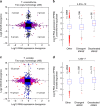Genome and transcriptome evolve separately in recently hybridized Trichosporon fungi
- PMID: 31341962
- PMCID: PMC6642101
- DOI: 10.1038/s42003-019-0515-2
Genome and transcriptome evolve separately in recently hybridized Trichosporon fungi
Abstract
Genome hybridization is an important evolutionary event that gives rise to species with novel capabilities. However, the merging of distinct genomes also brings together incompatible regulatory networks that must be resolved during the course of evolution. Understanding of the early stages of post-hybridization evolution is particularly important because changes in these stages have long-term evolutionary consequences. Here, via comparative transcriptomic analyses of two closely related, recently hybridized Trichosporon fungi, T. coremiiforme and T. ovoides, and three extant relatives, we show that early post-hybridization evolutionary processes occur separately at the gene sequence and gene expression levels but together contribute to the stabilization of hybrid genome and transcriptome. Our findings also highlight lineage-specific consequences of genome hybridization, revealing that the transcriptional regulatory dynamics in these hybrids responded completely differently to gene loss events: one involving both subgenomes and another that is strictly subgenome-specific.
Keywords: Evolutionary biology; Molecular evolution.
Figures



References
-
- Ohno, S. Evolution by Gene Duplication. (Springer, New York, 1970).
Publication types
MeSH terms
LinkOut - more resources
Full Text Sources
Research Materials

